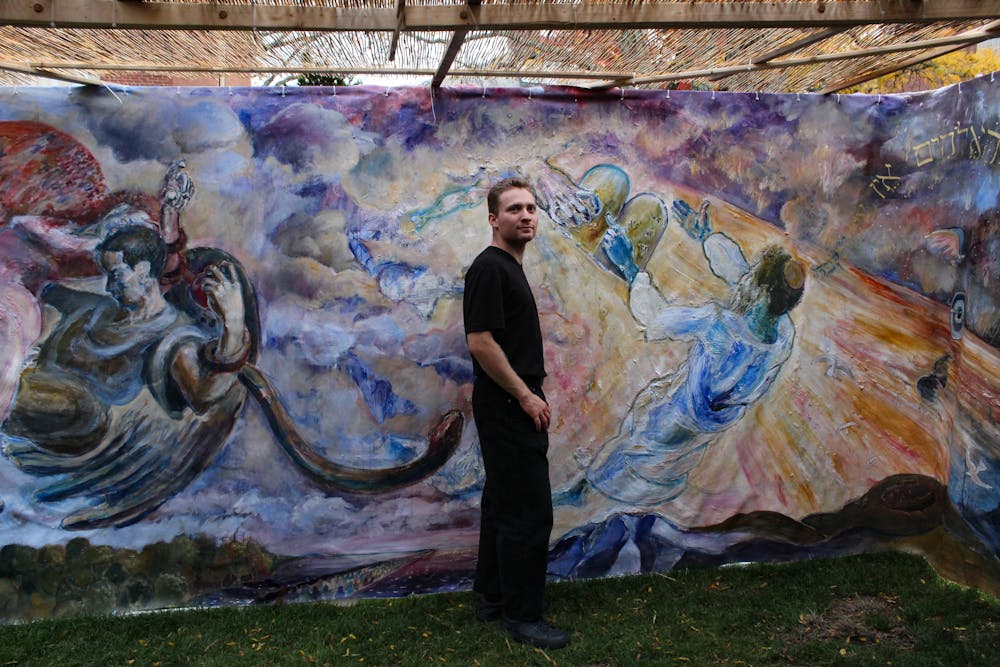After curating art shows at Brown RISD Hillel in his sophomore year, Jake Sheykhet ’25 took his artistic ability to Wriston Quad with a sukkah installation for the Sukkot holiday.
Sukkot is an ancient Jewish harvest festival following Rosh Hashanah and Yom Kippur, explained Rabbi Josh Bolton, the executive director of Brown RISD Hillel. The holiday highlights the importance of joy and faith, as well as the impermanence of life.
The holiday encourages individuals to go outside, both literally and symbolically, to temporarily escape the world’s demands. One of the most salient symbols of the week-long celebration is the sukkah — a temporary outdoor dwelling used for meals, sleeping and celebration.
Amid the holiday season, Deborah Forman, the first coordinator for arts engagement and education at Hillel, quickly noticed Sheykhet’s hardworking and creative nature.
After Forman sent him a picture of artist Aryeh Steinberger’s decorative sukkah from the 1920s, Sheykhet immediately began producing his own large-scale installation for Sukkot. While Forman provided the necessary space and materials for Sheykhet, who was accustomed to working on his art at a smaller scale, she said that the majority of the installation’s construction “was all Jake.”

Sheykhet’s murals depict various references to Jewish religion and history.
Courtesy of Jake Sheykhet
The first mural in the installation illustrates various scenes from the Torah, including narratives of Adam and Eve, the crossing of the Red Sea, Moses receiving the Torah at Sinai and a depiction of the Jewish prophetess Esther.
The second panel depicts more contemporary Jewish history, including the 12th-century scholar Maimonides, the Holocaust and the myth of the golem, a part of Jewish folklore regarding a clay figure brought to life in 16th-century Prague.
“I’ve always loved that myth,” Sheykhet said. “Bringing artwork to life resonates with me.”
Sheykhet started painting two 7-by-25 foot panels in the months before Sukkot. He used a variety of innovative techniques throughout the installation’s construction: He used zip ties to secure the structure’s framework and used a four-foot PVC pipe as an instrument to paint the expanse of the tapestries.
Forman, who provided artistic feedback throughout the installation, recalled Sheykhet arriving at Hillel early in the mornings to work on the murals, noting the extent of his “ruach,” the Hebrew word for “spirit.”
“His work ethic is really something to behold,” Forman said. “The spirit and the passion that Jake has as an artist really came through, and it was just such a pleasure to witness it.”

With support from Brown-RISD Hillel, Sheykhet started production of his large-scale sukkah installation with the intention of celebrating Jewish history through his art.
Courtesy of Drew Lerner
Bolton, who mentored Sheykhet and helped provide space for his art, also emphasized his pioneering spirit and pivotal role in building the Jewish arts community. He likened observing Sheykhet’s vision coming to fruition over the past months to “watching a performance spread out across the holiday season.” He also highlighted the installation as an example of “Jewish creativity, imagination and how lucky we are to see that in such a bold way on College Hill.”
In recent years, Brown RISD Hillel has expanded its support for student work across genres such as visual art, music and theater, according to Bolton.
Sheykhet also helped curate last year’s Judaica exposition, a multi-artist exhibition last spring. He has aimed to use his experiences to support, expand and embody Brown RISD Hillel’s artistic focus.
“So much of the discourse surrounding the holiday and surrounding Judaism is in the current geopolitics,” Sheykhet said when asked about the significance behind the installation. “I wanted to highlight something else: the story, because there’s a lot more to Judaism than what’s happening in the Middle East.”
Sheykhet hoped that the installation served as “a piece of our story as I see it.”





